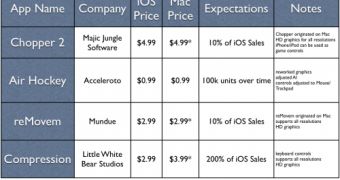Developers are starting to become vocal on the topic that is Apple’s forthcoming Mac App Store. Their initial impressions are interesting. Their pricing plans are even more intriguing, as revealed in a blog post by one such developer.
Markus Nigrin, head of Windmill Apps, a studio creating apps for iPhone, Android and Blackberry, used his Pocket Cyclone blog to share the results of a discussion he recently had with some fellow iOS developers who are looking to try their luck with the upcoming Mac App Store as well.
The four participants to the discussion are well known in the iOS world, Markus outlines.
One of them is Dave Frampton, of Majic Jungle Software, who has a Chopper 2 game on the launch pad for the Mac App Store.
Another is Bryan Duke, of Acceleroto - famous for the popular Air Hockey iOS game.
The other two are Matt Martell (Mundue), who created reMovem, and Craig Kemper (Little White Bear Studios), who coded a blocks puzzle game for iPad - Compression.
Markus quantifies that “Jointly, their iOS apps account for somewhere around 20 million downloads and I guess it’s safe to say those devs know their way around.”
During their discussion, Markus asked how the four successful Indie Devs see the opportunity of the Mac App Store.
Nigrin's results showed that at least these high-profile iOS developers were looking to maintain their existing price points, falling in the $1.99-$4.99 range.
But why, when they could easily charge for more, right? Well, not really, according to his friends.
“For once, Apple made the code re-use for a native Mac app very straightforward. Every dev I talked to mentioned porting times of less than four weeks,” Nigrin writes. “Which were mostly spent on all types of adjustments, like keyboard and HD support.”
“Also, graphical assets for mobile games are typically originated at a much higher resolution anyway, as everybody in the iOS world needs to prepare for a foreseeable future of HD displays,” he continues.
“The point is, if you already have the assets and re-creating a native Mac app is relatively low-cost, there is no immediate pressure to go with another pricing model on this platform, if the reward could be an early (chart) success,” Nigrin reveals.
In other words, what these devs are trying to do, or should we say not do, is scare the fish away on opening day.

 14 DAY TRIAL //
14 DAY TRIAL //